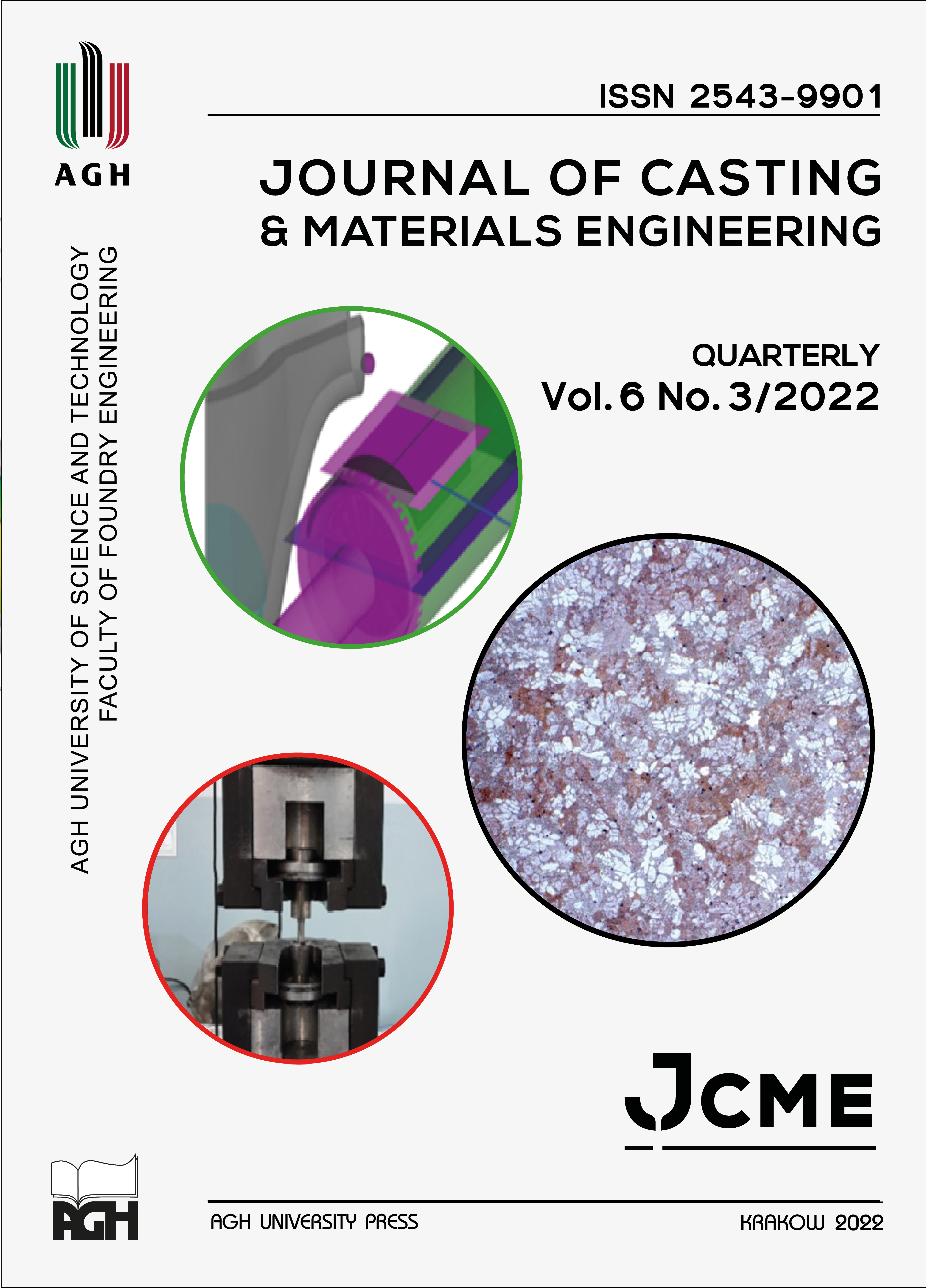Influence of the Cooling Rate on Damping Characteristics of the ZnAl4Cu1 Alloy
DOI:
https://doi.org/10.7494/jcme.2022.6.3.58Abstract
The paper presents the results of damping coefficient tests in the ZnAl4Cu1 alloy (ZL5). The damping coefficient has been calculated on the basis of specimen measurements obtained with the use of the signal echo method. The method consists in passing the ultrasonic wave through the tested material. The ultrasonic wave from a transmitting and receiving head passes through a specimen, bounces off its bottom surface and comes back to the measuring head in the form of a signal echo. Difference in the signal strength between the first and the second echo in relation to the distance travelled by the ultrasound wave is a measure of the material’s damping characteristics. The specimens were cast into three molds made of different materials, i.e. green sand, plaster and metal. Thermophysical properties of these materials are different what affecting the rate of heat absorption from the cast. Three series of specimens have been obtained which cooled at different rates. The specimens were then subjected to ultrasound and microscopic tests to assess the alloy structure. The internal alloy structure affects its damping properties to a great extent.
Downloads
References
Ritchie I.G. & Pan Z.-L. (1991). High damping metals and alloys. Metallurgical Transactions A, 22, 607–616. Doi: https://doi.org/10.1007/BF02670281.
Ritchie I.G., Pan Z.-L. & Goodwin F.E. (1991). Characterization of the damping properties of die-cast zinc-aluminum alloys. Metallurgical Transactions A, 22, 617–622. Doi: https://doi.org/10.1007/BF02670282.
Rzadkosz S. (1995). Wpływ składu chemicznego i przemian fazowych na właściwości tłumiące i mechaniczne stopów z układu aluminium – cynk. Rozprawy i Monografie. Kraków: Wydawnictwa AGH.
Krajewski W.K. (2013). Stopy cynku z aluminium. Rodzaje, właściwości, zastosowanie. Kraków: Wydawnictwo Naukowe AKAPIT.
Piwowarski G., Buraś J. & Szucki M. (2017). Influence of AlTi3C0.15 modification treatment on damping properties of ZnAl10 alloy. China Foundry, 14(4), 292–296. Doi: https://doi.org/10.1007/s41230-017-7070-6.
Krajewski W.K., Buraś J., Krajewski P.K. & Piwowarski G. (2015). Ultrasound wave attenuation of grain refined high-zinc aluminium sand-cast alloys. Archives of Foundry Engineering, 15(2), 51–54. Doi: https://doi.org/10.1515/afe-2015-0037.
Krajewski W.K., Haberl-Faerber K., Buras J. & Krajewski P.K. (2012). Damping properties vs. Structure fineness of the high--zinc aluminum alloys. Archives of Foundry Engineering, 12(3), 63–66. Doi: https://doi.org/10.2478/v10266-012-0083-0.
Lelito J., Żak P.L., Gracz B., Szucki M., Kalisz D., Malinowski P., Suchy J.S. & Krajewski W.K. (2015). Determination of substrate log-normal distribution in the AZ91/SiCp composite. Metalurgija, 54(1), 204–206.
Górny M. & Sikora G. (2015). Effect of titanium addition and cooling rate on primary α(Al) grains and tensile properties of Al-Cu Alloy. Journal of Materials Engineering and Performance, 24(3), 1150–1156. Doi: https://doi.org/10.1007/s11665-014-1380-2.
Shabestari S.G. & Malekan M. (2005). Thermal analysis study of the effect of the cooling rate on the mictrostructure and solidification parameters of 319 aluminum alloy. Canadian Metallurgical Quarterly, 44(3), 305–312. Doi: https://doi.org/10.1179/000844305794409409.
Osório W.R., Freire C.M. & Garcia A. (2005). The effect of the dendritic microstructure on the corrosion resistance of Zn-Al alloys. Journal of Alloys and Compounds, 397, 179–191. Doi: https://doi.org/10.1016/j.jallcom.2005.01.035.
Osório W.R., Freire C.M.A. & Garcia A. (2005). Dendritic solidification microstructure affecting mechanical and corrosion properties of a Zn4Al alloy. Journal of Materials Science, 40, 4493–4499. Doi: https://doi.org/10.1007/s10853-005-0852-z.
Osório W.R., Spinelli J.E., Cheung N. & Garcia A. (2006). Secondary dendrite arm spacing and solute redistribution effects on the corrosion resistance of Al-10 wt% Sn and Al-20 wt% Zn alloys. Materials Science and Engineering A, 420, 179–186. Doi: https://doi.org/10.1016/j.msea.2006.01.058.
Lachowicz M.M., Leśniewski T., Lachowicz M.B. & Jasionowski R. (2020). Tribological wear of as cast Zn-4Al alloy cooled at various rates from the eutectoid transformation temperature. Archives of Foundry Engineering, 20(4), 108–114. Doi: https://doi.org/10.24425/afe.2020.133356.
Savaşkan T., Pürçek G. & Hekimoğlu A.P. (2003). Effect of copper content on the mechanical and tribological properties of ZnAl27-based alloys. Tribology Letters, 15(3), 257–263. Doi: https://doi.org/10.1023/A:1024817304351.
Deputat J. (1979). Badania ultradźwiękowe. Podstawy. Gliwice: Instytut Metalurgii Żelaza.
Deputat J., Mackiewicz S. & Szelążek J. (2007). Problemy i techniki nieniszczących badań materiałów: wybrane wykłady. Warszawa: Biuro Gamma.
Petzow G. (1999). Metallographic Etching. Techniques for Metallography, Ceramography, Plastographyk. 2nd Ed. ASM International.
Downloads
Published
Issue
Section
License
Copyright (c) 2022 Grzegorz Piwowarski, Beata Gracz

This work is licensed under a Creative Commons Attribution 4.0 International License.
How to Cite
Accepted 2022-07-15
Published 2022-08-08


